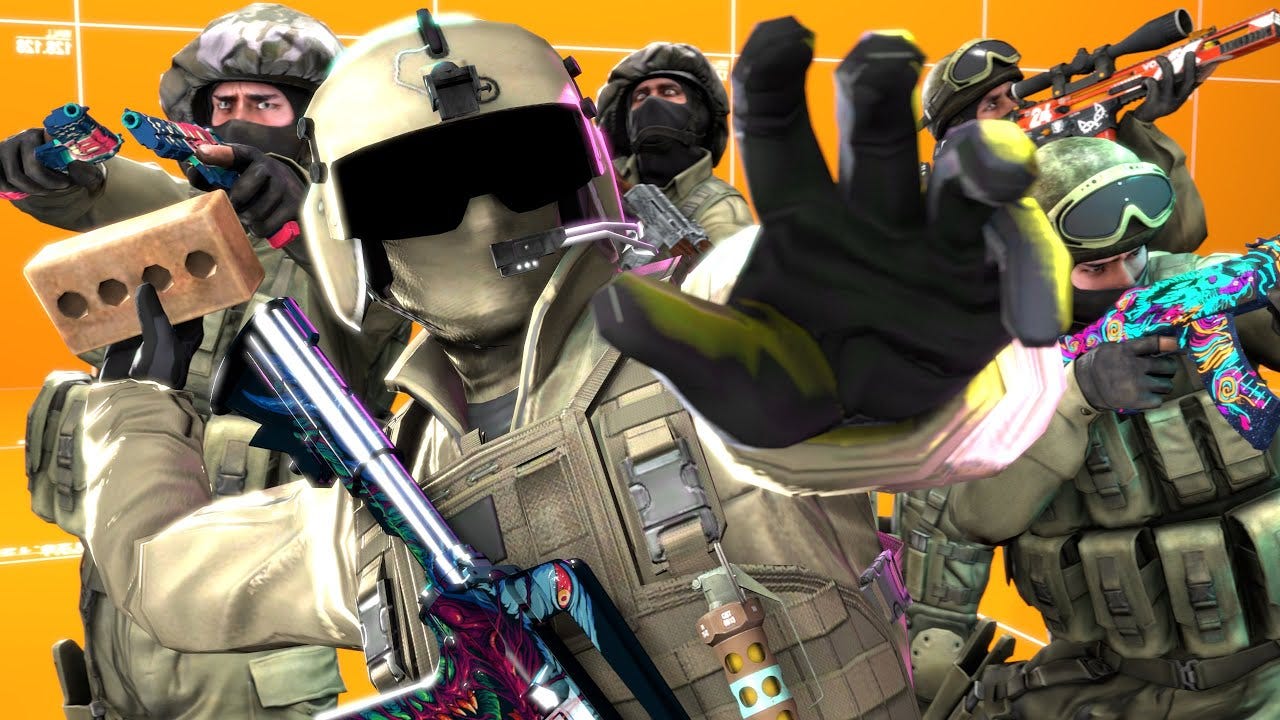EX is a research report about digital culture. You can learn more here. This week: Marvel vs. Capcom, Marvel vs. Ridley Scott, and Unity vs. Big Bill Hell.
1. What we talk about when we talk about ASMR games

It's been a long ride for ASMR. The original ASMR video trend that overtook YouTube in the early 2010s has spawned countless mutations, from sexually charged "ear-licking" Twitch streams to hour-long "Meg Griffin gives you a makeover" roleplays. Usage of the term "ASMR" has only become more elastic over time, and the trend has since embedded itself into gaming culture in two distinct ways. "ASMR games" typically refer to one of two things: They're either a) "chill" games favored by streamers and Let's Players with ASMR-ready audio setups, or b) mobile games that mash together many ASMR-adjacent trends found across social media.
The former category of ASMR games is especially flexible. Many ASMR streamers will stick to fairly conventional programming, performing ASMR over AAA "games of the moment" like Starfield or Baldur's Gate 3 regardless of the game's sound design. Even still, there are a couple of common curatorial trends. When YouTubers like JubileeWhispers post "best of ASMR games" lists, they're usually talking about "cozy games" that offer little friction and plenty of meditative, repetitive activities (e.g. Fae Farm and A Little to the Left). Channels like ASMRPlays and theASMRNerd, on the other hand, tend to favor open-world games like Skyrim and The Legend of Zelda: Breath of the Wild, taking advantage of their environmental soundscapes and natural appeals to wanderlust.
On the other hand, mobile ASMR games are pretty much what you'd expect: soulless digital adaptations of trends like soap-cutting and slime-fondling, bereft of the human performer who usually drives the sensory experience. But they also demonstrate just how far the term "ASMR" has strayed from its original usage, becoming a catch-all term for "relaxing" or "satisfying" content regardless of whether or not they produce actual ASMR sensations. Anyone who claims to get the ASMR tingles from this video is 100% lying.
2. A YouTuber who edits his streams into hyperactive 3D spectacles

TheRussianBadger is a high-energy YouTuber who uses mo-cap animation and After Effects to produce light-speed animated Shorts about gaming like this one. His virtual persona wears a tablet on his chest displaying memes that change at a rapid pace to punctuate different beats in the video. In many ways, it's obvious why this device would play well with a younger audience; kids love tablets, video games, and videos that slap text-to-speech audio of a Reddit post over footage of Subway Surfers.
But TheRussianBadger's longform videos go even harder. This video, for example, is a high-effort, 40-minute edit of a Marvel vs. Capcom tournament stream he hosted. But unlike most VODs or livestream edits, Badger's recap video is mostly composed of new, original material that relies on the mo-capped performance of multiple actors. New virtual screens are introduced nearly every five seconds as the shaky cam flies in and out of different windows; dozens of references to Discord memes abound; animated color-coded subtitles adorn every performer's avatar. All in all, it's uniquely designed for the attention span of the TikTok generation. Say what you will about Badger and co.'s sense of humor, but it's undeniable that a video with so many moving, intersecting parts is impressive, even if purely on a technical level; it illustrates how far YouTube has come since the days of Red vs. Blue and the advent of amateur machinima.
3. The auteurs strike back
Several prominent strains of film-buff discourse are set to collide this fall. After the pandemic shuttered movie theaters, dropping box-office revenue from over $11 billion in 2019 to $2.3 billion in 2020, many ululated the death of the big-screen cinematic experience. The preponderance of Marvel movies and foundling “cinematic universes” felt like an evolutionary dead-end. Filmmakers weighed in; Christopher Nolan and Tom Cruise urged people to go see everything, preferably with a huge tub of popcorn, while Scorsese more acutely diagnosed the problem, saying Marvel movies “aren’t cinema.” This summer’s smash success of Barbie and Oppenheimer — both helmed by writer-director virtuosos, both blissfully free of franchise baggage, and both grossing around $1 billion — were held up as proof that people are ready for “real movies” again, especially when contrasted with disappointing returns for long-standing series like Mission: Impossible, Indiana Jones, and The Fast & The Furious.
Into this environment comes an absolutely stacked fall movie slate, full of big-name directors taking huge swings. Last year’s abortive “magic of cinema” season — featuring treacly odes to the big screen by Spielberg, Chazelle, and Mendes, all of which flopped — has nothing on the onslaught of Letterboxd Bro faves incoming, featuring names like Yorgos Lanthimos (Poor Things, 12/8), Michael Mann (Ferrari, 12/25), David Fincher (The Killer, 10/28), Ridley Scott (Napoleon, 11/22), Martin Scorsese (Killers Of The Flower Moon, 10/20), Sofia Coppola (Priscilla, 10/27), Bradley Cooper (Maestro, 11/22), Harmony Korine (Aggro Dr1ft, 9/2), Jonathan Glazer (Zone Of Interest, 12/8), and Hayao Miyazaki (The Boy And The Heron, 12/8).
Recent trends in film discourse include an exhaustion with Letterboxd groupthink and the superficiality of so-called “MovieTok.” Expect all of these channels to swell to bursting when “Is Ridley Scott back?” becomes the conversation of the week.
4. Consultants: Gen Z ❤️ AI (IJBOL)
Earlier this year, the sci-fi writer Ted Chiang wrote an essay about AI for the New Yorker. In it, he compared the technology to the consulting firm McKinsey — "the willing executioners of capitalism," who would happily sweep into an organization and provide cover for executives by authorizing the ruthless reductions in headcount and quality of life assurances that have become de rigueur under late capitalism.
This week, two new studies, from Boston Consulting Group (via Harvard) and Salesforce, seem to prove Chiang’s thesis. Salesforce surveyed over 4,000 people on AI usage, and provides soon-to-be-extrapolated data points around so-called “super users,” like “65% of generative AI users are Millennials or Gen Z,” and “75% of users are looking to automate tasks at work.” BCG’s report, conducted on over 800 BCG employees, isolated a “jagged frontier” of work that can and cannot be done using AI at present, and delineated users between “centaurs,” who divide and delegate tasks between themselves and the AI, and “cyborgs,” who more fully integrate their work with the technology.
The key word to search for on either report is “productivity” — quality metrics are only a check against the possible market impact of increased productivity by workers. Can it be good enough? Can the units produce more? It’s impossible to take the research at face value given the malevolent ends toward which it could be twisted — if not by the firms that produced the data then by executives eager to automate the messy business of creative work.
5. Anime cat brings unusual energy to AI covers
Look, nobody is going to thank us for posting another glitchy AI cover. However, if you skip to around 60 seconds in this clip and wait for the “whoas”, you will hear something beyond all expectation. It really does sound like an anime cat-gremlin shrieking at karaoke while being throttled by Jon Arbuckle.
The character here is Neco-Arc, an anime mascot for a sprawling franchise. Neco-Arc already had dedicated fans, but saw a notable spike of interest in August following a “little bit of chicken fried” AI cover/animation that became inescapable on Discord. A wave of other YouTube covers followed, made by AI heads seemingly drawn to the vocal model’s alternation between “VTuber baby voice” and “goblin burning in fireplace.” One commenter theorized that characters like Neco-Arc and Plankton “make the best covers” because they yell a lot, “which makes the part of the music where they put more power into their voice sound passionate.”
6. Return to Lavender Island
We last mentioned the surreal open-world indie game Escape from Lavender Island two weeks ago. Since then, it’s gotten an unexpected boost from Cr1TiKaL, one of YouTube’s biggest gaming creators. He runs an occasional “$10,000 speedrun challenge” where his community and itinerant speedrunners compete to set the fastest time in an obscure Steam game with no competitive history. Previous contests featured odd Z-list titles like Exodus from the Earth, but he announced he’d change it up with Lavender Island, a game he considered “extremely good.” The contest announcement on the 18th caused a visible jump in sales and player count, as you’d expect — Cr1tiKal’s basically running a giant promotion on the game’s behalf.
If you’re interested, you can track runners’ progress on speedrun.com. Times have already fallen from 23 minutes to sub-9.
YouTube Thumbnail of the Week

Chum Box
- The weird facial animations of Mortal Kombat 1’s poor Switch port stole the spotlight from this clip, one of the purest glitches of all time, in which the fundamental conceit of a 2D fighter — two combatants on a single plane — gets marvelously skewed.
- The Harry Styles fandom is tearing itself apart due to a recent influx of supposedly leaked songs that may or may not be A.I.-generated.
- You won't be pushing around ol' Easy Pete in Fallout: New Vegas anymore — Difficult Pete has arisen.
- Paradox Interactive is finding success marketing Hearts of Iron IV on YouTube Shorts by using the game to surface obscure historical facts. It's a shrewd approach to targeting a platform that traffics heavily in edutainment.
- French President Emmanuel Macron apologized to gamers on Twitter after using them as scapegoats for the riots in July.
- “THE FUTURE SUCKS”: artisan meme-maker @Kinofabino’s new collage stands as the last word on modern RPGs. He previously weighed in on the differences between East and West.
- Only 12.5% of the creatives who start making a Star Wars movie are still standing when it comes out.
- Here’s a compilation of different samples used in Akira Yamaoka’s Silent Hill 1-4 soundtracks (via Andy Kelly). “Silent Hill ambience” playlists are huge on YouTube, and snippets of tracks like “Morning Calm” pop up all over the place in short-form video.
- Hideo Kojima did one of Criterion’s film closet videos. He’s right about High and Low — pick up a copy the next time you get invited to Criterion’s film closet.
- The immortal “Big Bill Hell’s” auto ad was remade by angry Unity devs. (Incidentally, here’s the original ad that Big Bill Hell’s was sending up.)
That’s it for this week. See you in the dream dog house.

